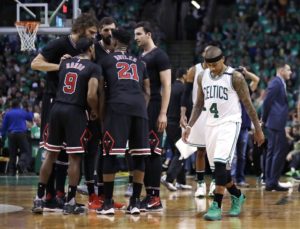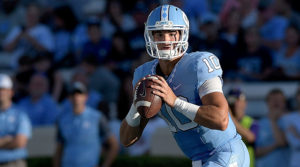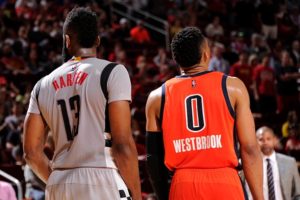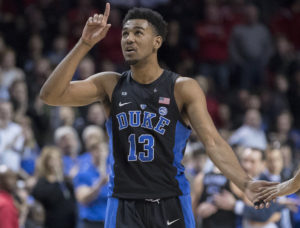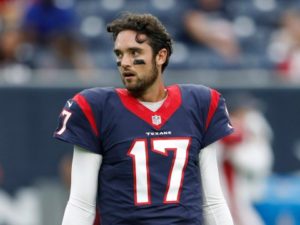
On May 3, 2013, the current state of the Boston Celtics would have seemed unimaginable to even the team’s most ardent fans.
That night, the Celtics lost Game 6 of their first-round series against the New York Knicks and were eliminated from the playoffs. Two-thirds of Boston’s so-called “Big Three” (Paul Pierce and Kevin Garnett) were still with the organization while the other member (Ray Allen) had left before the start of the season to join the Miami Heat. Pierce was under contract for one more year while Garnett was locked up for another two; however, with the team’s decline from championship contender to fringe playoff team, Celtics’ GM and President of Basketball Operations Danny Ainge would have a decision to make: ride out the length of their contracts or deal them to a team crazy enough to give up key assets for their services. At the same time, the front office needed to figure out what to do with coach Doc Rivers, who would have been less than willing to endure a rebuild and wanted more organizational influence; Boston later responded by dealing Rivers to the Los Angeles Clippers for a 2015 protected first round pick. Still, the situation remained with Pierce and Garnett.
As it turns out, the Brooklyn Nets were willing to help out the Celtics with their dilemma.
On June 28 of that year, the Nets acquired Pierce, Garnett, and Jason Terry in exchange for several role players, the most notable of whom being Kris Humphries and Gerald Wallace. Here’s the kicker: the Nets also sent their first-round picks for 2014, 2016, and 2018 to Boston, as well as the right to swap picks this year, something the Celtics are going to take advantage of in the draft lottery. However, both sides were happy: the Celtics got a truckload of draft picks while the Nets got three additional pieces they thought could help them win a championship; Nets owner Mikhail Prokhorov proclaimed shortly after the trade that “the basketball gods smiled on the Nets”. Little did he know just how wrong he would be; Pierce and Garnett played just one season together in Brooklyn before the former signed with the Wizards in the summer of 2014 and the latter was traded to the Minnesota Timberwolves at the 2015 trade deadline. Terry left the Nets and signed with the Rockets the next year.
The C’s predictably struggled in the 2013-14 season, winning just 25 games under first-time NBA head coach Brad Stevens. With just 23 games gone by in the next season and with the team sitting at 9-14, Ainge decided to trade star point guard Rajon Rondo to the Dallas Mavericks for three players, including Jae Crowder. Crowder is currently a significant contributor to the Celtics’ success, as he has started all of the team’s playoff games in the last two seasons. At the time, the deal looked like a classic sell move from a team looking to slowly work back towards contention. In hindsight, it looks like a steal for Boston; Rondo played just 46 games in a Maverick uniform before signing with the Kings after the end of the season.
The move, though, didn’t pay off right away: the Celtics slumped to a 20-31 mark at the All-Star break and did not appear to be in playoff contention heading into the trade deadline. One team that was looking at self-improvement for a playoff push was the Phoenix Suns; the Suns had already dealt guard Goran Dragic to the Miami Heat after he demanded a trade because of disagreements with the front office and then-head coach Jeff Hornacek. The Dragic deal necessitated the team’s acquisition of Bucks shooting guard Brandon Knight. With Knight’s acquisition, Phoenix and general manager Ryan McDonough looked to remedy the team’s crowded backcourt situation, as the Suns had played with three starting-caliber guards in the rotation for the first half of the year. That led the organization to ship Isaiah Thomas to Boston in a three-team deal that spawned the Suns….. Marcus Thornton and Boston’s 2016 first round draft pick. Whoops.
The rest is more or less history; the Celtics went 20-11 to close out that season and went to the playoffs where they were quickly dispatched by the Cleveland Cavaliers in four games. You may remember that series for this play but not much else. Ainge laid low over the summer of 2015 and over the remainder of the next season, as Boston’s most significant transaction was acquiring forward Amir Johnson in free agency. The Celtics continued to improve, and Thomas took over as the team’s starting point guard and undisputed face of the franchise. While the C’s lost in six games to the Atlanta Hawks in the first round of the 2016 playoffs, the team was clearly ahead of schedule in their rebuilding process.
Last summer, Ainge and the Celtics front office made their biggest splash yet, signing star center Al Horford to a four-year, $113 million contract; Horford was part of the Atlanta team that defeated Boston the year prior. With Horford in the fold and the rest of the core together for another year, the Celtics took another leap, finishing with 53 wins and, in a down year for the Eastern Conference, the number one seed in the playoffs. While some posited that they were the worst one-seed the league has ever seen (wonder who that could be), the accomplishment was still noteworthy for a team that looked to be locked in a long-term rebuild at this same time just three years ago.
Now, the Boston Celtics find themselves in the Eastern Conference Finals after defeating the Washington Wizards in a deciding game 7. Kelly Olynyk, a forgotten piece of the Celtics’ resurgence, went for a playoff-career-high 26 points, Thomas went for 29, and the Celtics moved on after a series in which the home team won every single game. This comes on the heels of Boston being down two games to none to the Rajon Rondo-led Chicago Bulls (yes, him again). Rondo missed the last four games of that series, all of which went to the Celtics.
It’s fair to argue that the Boston Celtics had lots and lots of luck in getting to this point. The Thomas trade, the Nets giving them most of their draft picks for half of a decade, the Bulls losing Rondo, etc. But it is impressive that Ainge and the Boston front office was able to rebuild the roster so quickly after having very little to work from not long ago.
Also, consider this: the Celtics could get the number one overall pick in tonight’s NBA draft lottery. Because the Nets (very dumbly) allowed Boston to swap picks this year and the Nets had the worst record in the NBA, the Celtics have a one-in-four chance to earn the top pick. And, because they have the most ping-pong balls in the lottery, Boston cannot pick any lower than fourth overall. Then, think about how loaded this year’s draft is; with the Celtics’ standing, they could end up with any one of Markelle Fultz, Lonzo Ball, Josh Jackson, DeAaron Fox, Malik Monk, or Jayson Tatum, all of whom could help the team from day one. And if they want to make a run at a championship for next year, they could draft any one of those players and trade him to a rebuilding team for a more established player or players, such as the Bulls’ Jimmy Butler or the Pacers’ Paul George. I’m not suggesting this would definitely happen, but it should be on the table when Boston makes their selection.
Also, this is not meant to suggest that Boston will defeat the Cleveland Cavaliers in this year’s Eastern Conference Finals. Cleveland has shown itself to be the far superior team over the course of the season and so far in these playoffs, so it would be a major shock to see Boston come out on top in the series.
Nevertheless, it is an incredibly impressive achievement for a team that will earn a top-four pick in the draft tonight and open the Eastern Conference Finals at home tomorrow.


/cdn0.vox-cdn.com/uploads/chorus_image/image/54652739/usa_today_10043763.0.jpg)
